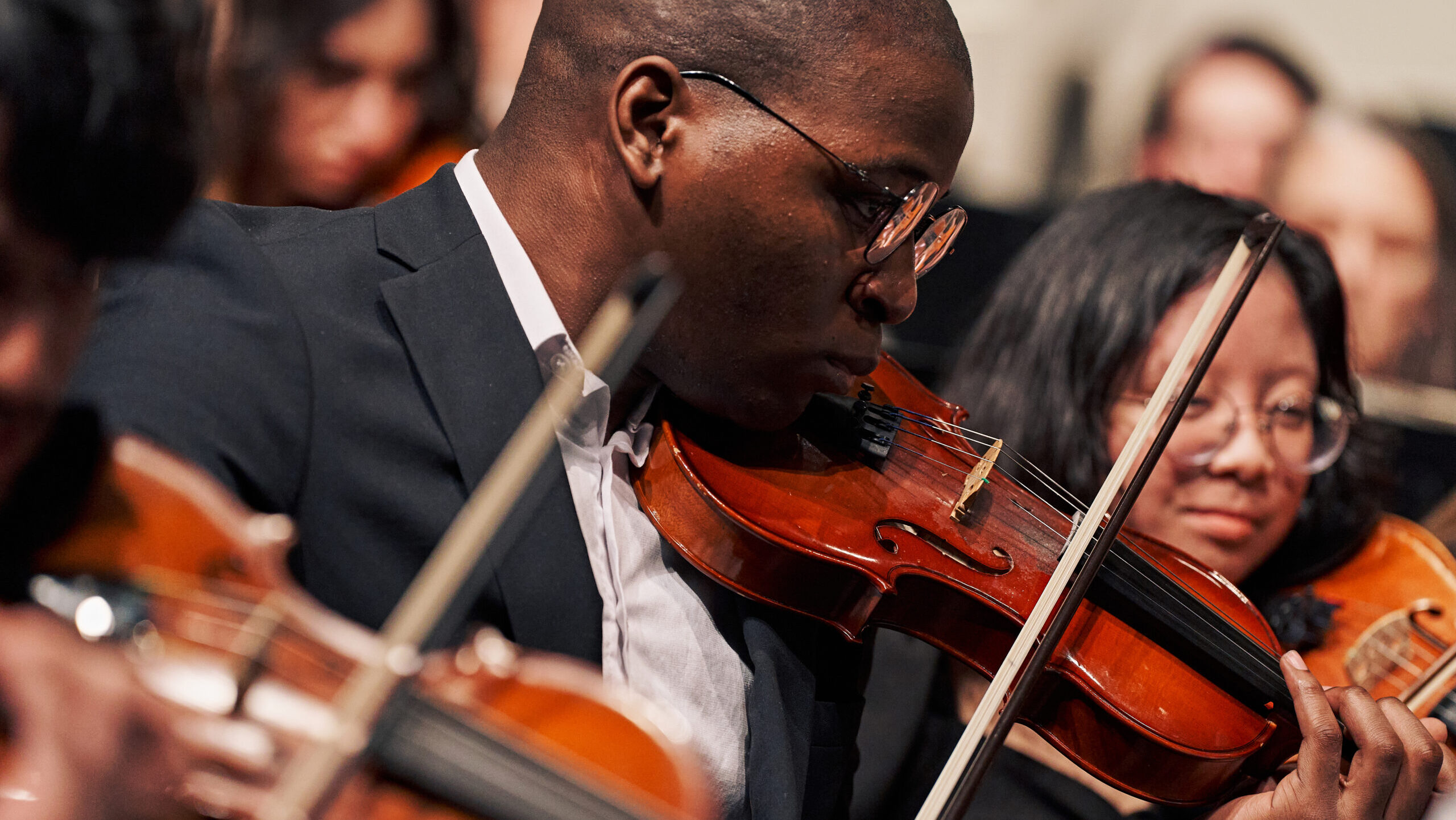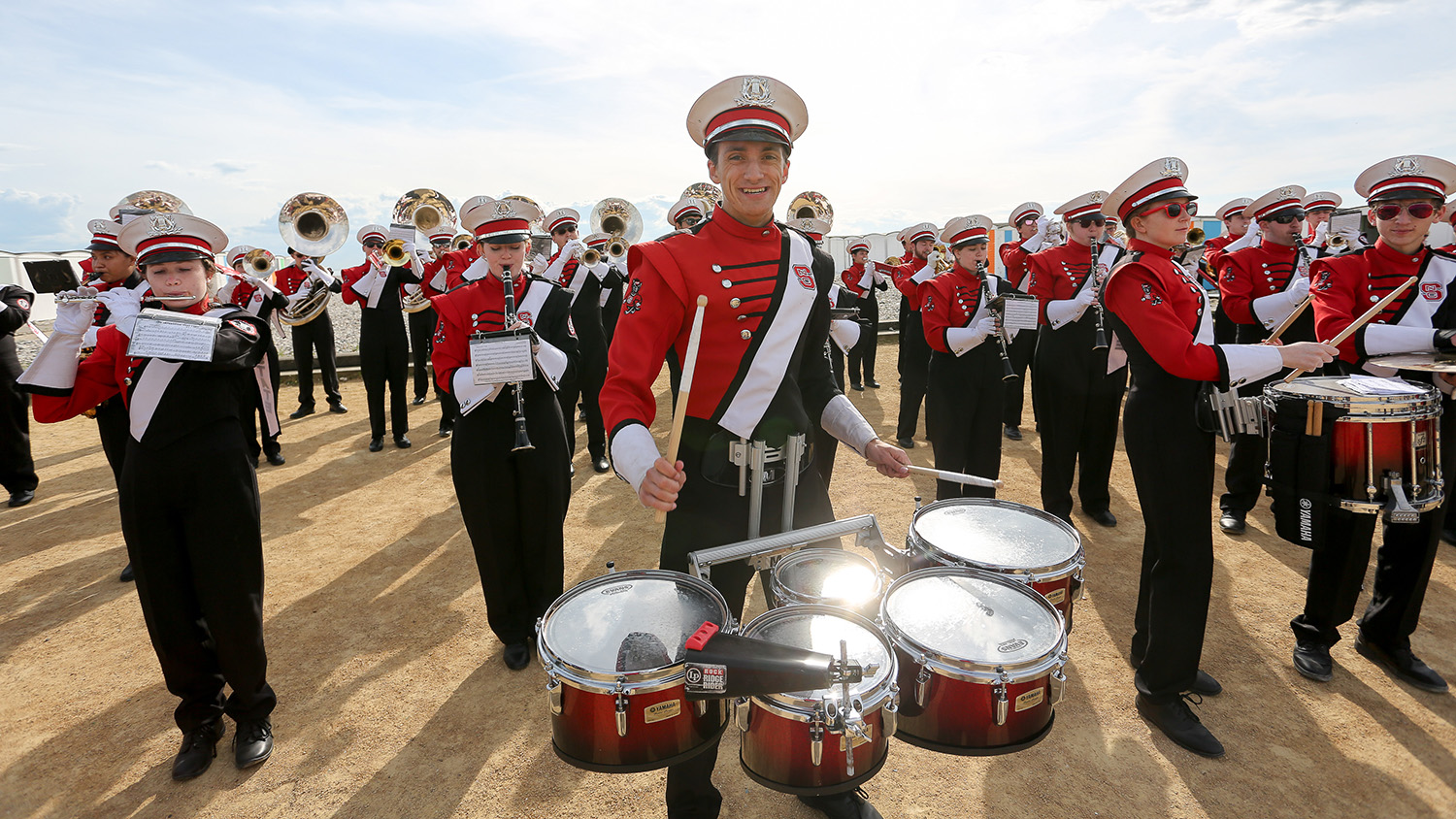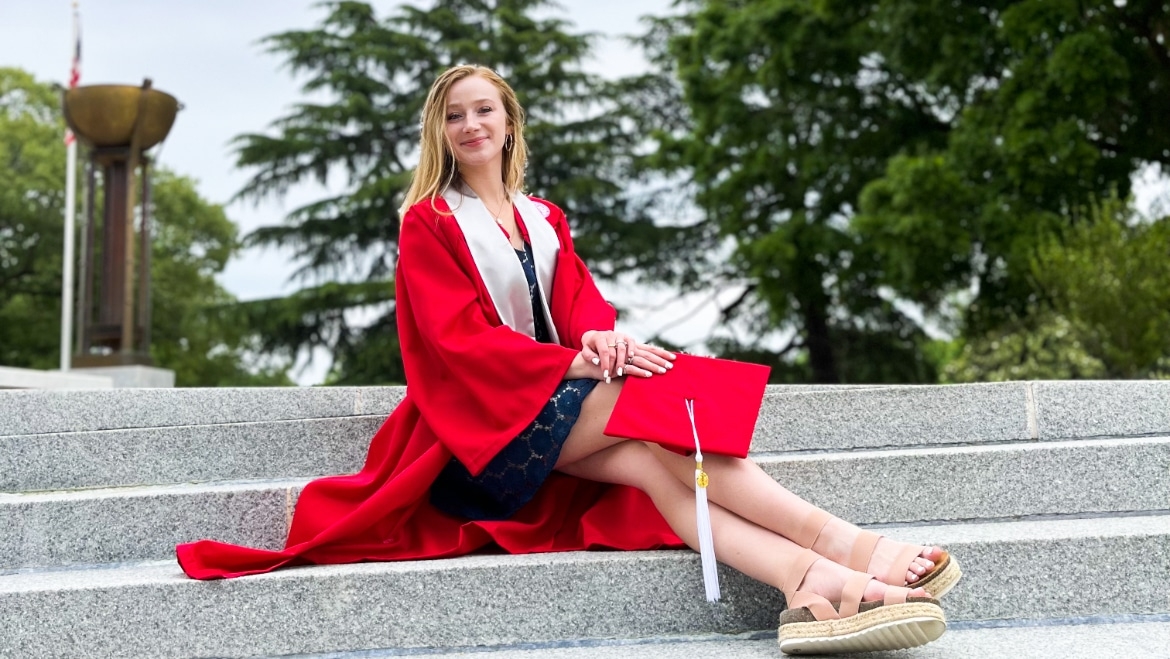Bringing new music to life
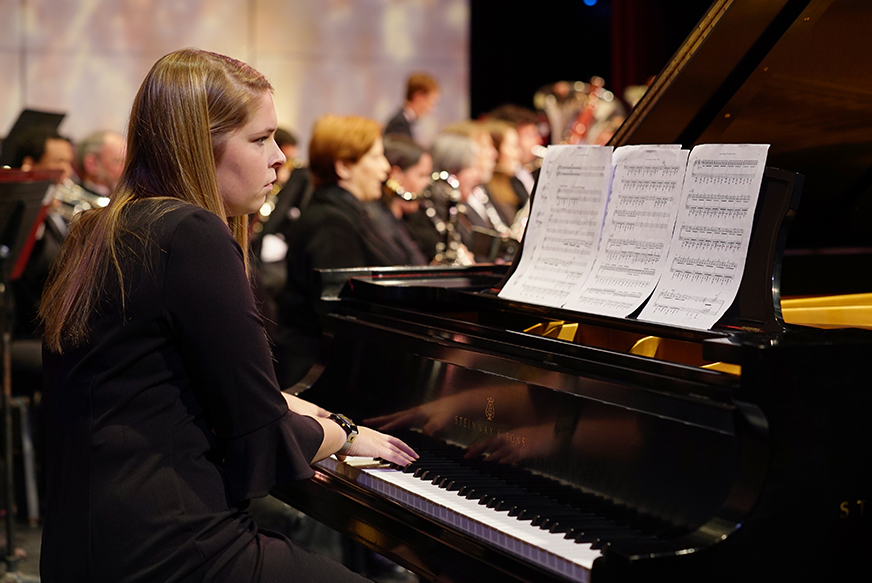
Author’s note: This article was written and published in our spring 2020 issue of Wolf Tones prior to the decision to cancel on-campus events due to the coronavirus outbreak. To reduce confusion, we have removed information originally included at the end of the article regarding the dates of the spring orchestra concerts. It can be read in its original form in the digital version of Wolf Tones.
Beethoven. Mozart. Brahms. The classical canon. When students think of orchestral composers, these are the names that spring to mind; European men who died over a century ago. Peter Askim is on a mission to change that.
The orchestras of NC State—the Raleigh Civic Symphony and Chamber Orchestra—are unique among their fellow ensembles in that they are open to both NC State students and community musicians. They’re also unique in their mission—and director Peter Askim’s personal mandate—to include a world premiere of a newly commissioned work in every concert. Askim, an associate teaching professor and director of orchestral activities in the Department of Music, will celebrate the orchestras’ 20th world premiere over his five years at NC State in April.
The programs Askim curates for the orchestra concerts tend to revolve around a chosen theme, with the world premiere serving as the centerpiece. Recent themes have included the women’s suffrage movement, the legacy of Dr. Martin Luther King, Jr., love and loss, and the phases of the moon.
Music for modern life
Askim’s career encompasses a breadth of music-making experiences and technical knowledge as a musician, conductor, composer and educator that lend context to his passion for helping new works of music find their way into the world.
[pullquote cite=”Peter Askim” color=”pyromanflame” align=”alignright”]We don’t wake up in the morning and feel like Mozart because we’re not living in his world.[/pullquote]
He sees his role in part as that of a translator. “For me that’s this great puzzle, is trying to be the link between the vision and the doing, and make all the cogs work together. I don’t know, it just gets me jazzed. It’s really interesting. It’s like people speaking three different languages, and I have to translate between the languages; or maybe different dialects of the same language. I say to the performers, ‘When the composer says this, this is what they mean.’”
There are pedagogical advantages to teaching new works. For one, students can’t listen to a recording in order to get their bearings, since no recording exists. They must rely on their ability to translate the notes on the page into music. Students also get a chance to meet the composers and feel their passion for their art first-hand. There are also obvious reasons to perform Beethoven, Mozart and the other staples of the orchestral canon, particularly when working with students. There’s value in learning the musical foundation for our understanding of what an orchestra is. By virtue of Askim’s teaching and concert programming, his students and his audiences understand that important, quality orchestral music didn’t stop being written in the 1800s.
“Music is constantly changing and, looking back throughout all of history, we’re able to see that change, but it’s starting to change even more and even faster now,” said violin performance minor Caroline Branan, a second year biological sciences and marine science major who performs in the Raleigh Civic Symphony. “I think a lot of it has to do with technology. The circulation of ideas is exponentially faster…And once new ideas are formed, people are moving on to the next thing. It’s all about the next thing, it’s all about the new thing, and it’s all about keeping it fresh.”
Askim has seen over time that musicians in his orchestras have come to look forward to tackling the next new piece. “They like the thing that pushes them and challenges them and, frankly, that’s written by somebody that’s living now, having the same kind of life experiences that we’re having,” he said. “We don’t wake up in the morning and feel like Mozart because we’re not living in his world. This is somebody that’s waking up to the same world that we are.”
Learning a new musical language
The students in Askim’s orchestras encounter unique opportunities and challenges with each world premiere. The process of connecting to a new piece of music is something that cellist Charlie Frazier, a third year math major and music performance minor who performs in both orchestras, has particularly enjoyed.
“I think it’s actually a lot more fun playing these [new] pieces because you don’t have your teacher, or your conductor, or Sonny [Enslen, the principal cellist]—you don’t have someone who’s already played it 50 times and knows exactly what’s going on,” Frazier said. “Everyone’s kind of on level playing field when you first approach a piece like that, and being able to kind of play with different texture and different styles of bowing when you’re in the first couple of weeks tackling it, is very interesting.”
Cellist Bryant Cox, a third year math and statistics major who performs in both orchestras, especially enjoyed working on one of Askim’s compositions for the chamber orchestra, Autumn Landscape: 3 Songs on Ho Xuân Huang’s Poetry, in the spring of 2019. “It was nice because he could tell us what he really meant to happen,” said Cox. “He could lead us through. If something was unclear, we could just ask him. That’s what’s also been nice about the previous newly commissioned pieces, when the composer will come and say, ‘Oh, I really meant for you to play it this way,’ or he can tell us what he wants more or less of. It’s very informative, and definitely unique.”
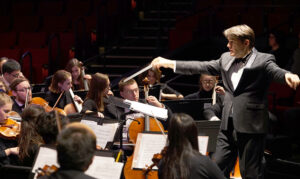 Askim sees each new work as an opportunity for his students to learn to speak and understand a new musical language. In the fall of 2019, Frazier connected with the language of composer James Budinich in his piece Tiled Fields. “You know when you play a piece and it’s not necessarily for the audience? That’s what that piece was like,” she said. “Everything was so simple. We had quarter notes, and we had half notes, and some whole notes, and nothing was too technically difficult. But the way that everything ended up weaving together—I remember Dr. Askim said something about, you’re supposed to feel like you’re standing in a moment where everything is beautiful…And [taking] that thought of ‘everything is beautiful’ and having to fit even the most simple of melodies and the most simple of chord progressions into that emotion was transcendent.”
Askim sees each new work as an opportunity for his students to learn to speak and understand a new musical language. In the fall of 2019, Frazier connected with the language of composer James Budinich in his piece Tiled Fields. “You know when you play a piece and it’s not necessarily for the audience? That’s what that piece was like,” she said. “Everything was so simple. We had quarter notes, and we had half notes, and some whole notes, and nothing was too technically difficult. But the way that everything ended up weaving together—I remember Dr. Askim said something about, you’re supposed to feel like you’re standing in a moment where everything is beautiful…And [taking] that thought of ‘everything is beautiful’ and having to fit even the most simple of melodies and the most simple of chord progressions into that emotion was transcendent.”
Violist Ralph Farris of the quartet ETHEL, who performed as a guest soloist with the chamber orchestra on the world premiere of Donald Reid Womack’s Blue Ridge Seasons: A Bluegrass Viola Concerto in the fall of 2018, said that the variety of new works paired with the classics helps students grow into versatile musicians. “In no way is an orchestra just about playing symphonies or tone poems or movie scores or just concertos,” said Farris. “An orchestra is an extraordinary, versatile instrument, and to be able to showcase the orchestra—as I recall, they did Appalachian Spring on that program when I played with them—to have them feature in that gorgeous piece, and such a fabulous pairing with the concerto, and then to show that they can also play such a powerful and inspiring supporting role in the context of concerto performance, it’s really a testament to how strong this group is and what a beautiful and versatile program Peter is building.”
Finding their voice
For many of the composers Askim commissions, working with the NC State orchestras will be their first time writing for a full orchestra. This was the case for violist, composer and educator Jessica Meyer, who said working with Askim was a fantastic opportunity that came along exactly when she was ready. She jumped at the chance to write Actions Speak in 2017.
“Peter does such a service, because in the rest of the community, the typical pipeline for most composers [is] they go to conservatory, they study, and then their teacher hooks them up with either certain people that they are connected with or they’re young enough to apply for all these awards,” said Meyer. “Whereas I would say a lot of the composers that wrote for Peter, like me, and Paul Wiancko, and Allison Loggins-Hull—I mean, I didn’t study composition and I’m in my 40s, so I’m approaching all of this later in my career—our pipeline is just different. It’s really about having colleagues that know who you are and are able to give you that opportunity for you to find your voice.”
[pullquote cite=”Peter Askim” color=”pyromanflame” align=”alignright”]I want to hear what lots of different people, from different backgrounds, with different life experiences and different musical visions will do, given the palette of our orchestra, and revel in that.[/pullquote]
Meyer said there are plenty of new music opportunities for composers who are 35 years old or younger, but fewer if you get started past that cutoff. “I think it’s becoming more and more obvious that those kinds of traditional paths are breaking down and people are just making their own paths,” she said. “So that’s why it’s so incredibly important for someone like Peter to have an institution like North Carolina State who is willing to give those opportunities. Because in most of the orchestral world, they’re not taking those kinds of risks at all.”
Composer and jazz bassist Rufus Reid, whose piece Lake Tyrrell in Innisfree premiered in the spring of 2017, said it takes audacity to write new orchestral music, given the hundreds of years’ worth of wonderful music that orchestras can already program. When asked where his compositional audacity came from, he laughed and said, “As a jazz musician, as an improviser, I live for the unknown in a sense. It’s even more difficult for me to play the same thing twice, or three times, or four times. It drives me nuts. But I understand that the animal of the symphony orchestra is just different. It doesn’t think the same way. So I had to learn how to think like them so that I can be much more successful in whatever I give them.
“We need people like Peter Askim because that’s part of his mandate, to challenge the orchestra,” he added. “It’s good for the composers, and it’s also good for the students, and it’s also good for the people who come to hear the orchestra, because most people don’t like change. But if they learn to trust that Peter’s not just going to make them listen to some junk, there’s a trust that he’s going to challenge them but he’s also working, developing the students, and he’s developing the audience to have a little wider palette. So that’s healthy. That’s a win-win situation, I think.”
Evolution of music and human experience
Perhaps the most essential driver behind the orchestra program’s mission of championing living composers is the need to keep music moving forward via the introduction of new voices. Farris is a firm believer that industries die when they stop introducing new ideas.
“What Peter is up to is reinvigorating that conversation and saying yes, I’m going to give you your classics…I’m going to show you the work that we all know and love, and then I’m going to challenge you and put something on the table to offer to you as an option for something fresh and new that reinvigorates our art form, keeps us fresh, keeps us alive, keeps us inspired, and also supports our active musicians in the community today.”
Askim has a deep appreciation for how a composer’s perspective shapes their music. He hopes to transmit that appreciation to his students and audiences.
“I want to hear what lots of different people, from different backgrounds, with different life experiences and different musical visions will do, given the palette of our orchestra, and revel in that,” said Askim. “This person is going to write a different piece that’s gonna be totally different from anything that we’ve played before because they have a different life experience. And I think that’s really interesting. It’s not a bug, it’s a feature.”
It’s a sentiment that cello performance minor Frazier shares. “I don’t want to play the same rich people waltz every five minutes. I just don’t want to,” she said. “And I’ve been part of orchestras where that’s all they wanted to play. It’s so important. I remember even when I first got into orchestra, even just looking at a sampling of section leaders and principles, they all kinda look the same. And then you look at the composers and they all kinda look the same…When you look at the people in power in music, they all fit a profile and I definitely don’t think that they should. Because if we’re trying to express something deep—almost innate beyond words, even—about the human experience through music, I want to hear about more than one human experience.”
On the cutting edge of the discipline
What the orchestras do every semester is breathe life into a composer’s vision; something that’s been taking shape inside of them, that holds meaning to them, and that might never exist if not for this commission.
For Farris, who has been friends with Askim since they were kids performing in a youth orchestra together, there’s a certain element of pride in his friend’s commitment to supporting the music community through his work at NC State and beyond. “Peter’s commission [of Blue Ridge Seasons] brought a new work to life that violists can use and orchestras can program, and it’s such a great boon to our industry and to the concert audiences around the world.”
Askim’s commitment to providing opportunities to living composers is being recognized by foundations and advocacy groups. The orchestras, through their booster organization the Raleigh Civic Symphony Association, recently received grants from New Music USA, the Aaron Copland Fund for Music and the Women’s Philharmonic Association to support their commissions.
Askim views workshopping and premiering new works of music as being firmly in line with NC State’s mission as a research institution.
“Everybody across campus is at the cutting edge of their particular discipline, finding out the thing that hasn’t been discovered yet,” he said. “And I feel like that’s what we’re doing here, is finding that thing that nobody else has done, that’s next. So on a bunch of different levels I think it’s a great experience for the students. They see that, number one, what they’re doing is research. And number two, that there’s many different kinds of music being written today and many different languages, and just the whole breadth of contemporary music.
“I try to stress to them that it’s not enough to just sort of play the piece. This is the first time anybody’s heard this music. If you play it badly, it might be the only time that anybody hears it. So we have a duty to be excellent. So whatever they do in their career, that’s what I hope they take away—curiosity and a sense that what you do matters, and it has to be quality…If you’re going to be an engineer, make the best bridge you can, because it matters.” ♪
[callout bodyfontface=”glypha” headingicon=”noicon” url=”https://performingartstech.dasa.ncsu.edu/about/wolf-tones/” type=”img” bgcolor=”reynoldsred” img=”14616″ mediaposition=”left”]This article first appeared in the spring 2020 issue of Wolf Tones magazine. You can read the rest of the digital magazine here.[/callout]
- Categories:
